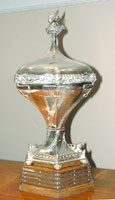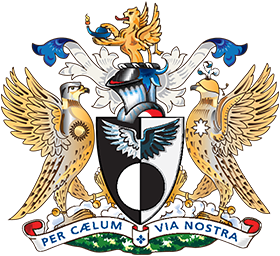- Home
- What we do
- News and Comment
- Scholarships
- International Air Pilots
- +44 (0) 20 7404 4032
- Member Login
The Cumberbatch Trophy
Awarded for an outstanding contribution to aviation safety.
2023 awarded to: Lieutenant Craig Allen RN

Lieutenant Craig Allen is employed as the Risk Manager for Merlin Helicopter Force at RNAS Culdrose. A non-aviator, he has stepped into a traditionally aircrew environment and has far exceeded his expected tasks and significantly improved not only Merlin Helicopter Force safety and risk management but developed tools and systems transferrable to the whole military aviation fleet, with potential to improve Defence-wide aviation safety and risk management using an evidence based, forward looking, approach.
Initially temporarily assigned to Merlin Helicopter Force, Lt Allen began looking at the complex problem of scoring and measuring how effective procedures, equipment and measures (barriers) are at preventing a risk- based event such as mid-air collision, as part of the Bow-Tie risk management system. The capability of this process relied on a panel of experienced and qualified personnel being assembled to “score” activities using judgement and experience to measure the effectiveness of these barriers.
While deemed acceptable by the Regulatory Authority, he identified that this system offered no qualitative system of underpinning the scoring, meaning the effectiveness of the barrier could be flawed or manipulated by the makeup of the panel. Self-taught on Power BI, a Microsoft tool for business analytics that lets you visualise your data and share insights, Lt Allen sought to develop a system for cross-mapping Defence Aviation Safety and Occurrence Reports and scoring them against barriers. Using these scores, the person responsible for the barrier and Risk to Life duty holders can see where they have effective barriers and easily identify where their system has weak points that could lead to an accident chain.
While developing this, Lt Allen further identified that the Air System Safety Case also relied on a series of subjective statements in the ‘Claim-Argument-Evidence’ based document, where the evidence was buried deep in the Defence Aviation Safety and Occurrence Reporting system, or again through subjective panels of experienced and qualified personnel.
Creating further Power BI tools in liaison with an RN Safety Manager and Military Aviation Authority experts, he has implemented a system that enables the Defence Aviation Safety and Occurrence Reports to be scored against both Bow-Tie barriers, and also Air System Safety Case sub-claims, giving a reliable, evidence based, qualitative assessment of risk up to risk to life holding Admiral level.
It will take time to fully realise the benefits of Lt Allen’s work, this is due to the time it will take to further build the database of Defence Aviation Safety and Occurrence Reports evidence, but in the meantime, the systems he has developed are being used to provide early warning of failing barriers, alerting owners that changes are needed, while also providing underpinning evidence to the Air System Safety Case. His work could ultimately lead to early identification of a hidden risk and prevent an accident from happening. Attracting much attention, his work has been briefed to the Rear Admiral of the Fleet Air Arm, and wider to the Military Aviation Authority who are working with him to take this on for employment across the defence estate.
Working largely unaided, innovatively, self-teaching en-route, and achieving well beyond the bounds of his Terms of References, Lt Allen identified an area that undermined aviation safety and dedicated his time to establishing a system to address potential safety shortfalls. It is not possible to say for certain if he has prevented an accident, but what he has done is establish a system that moves risk management and scoring from subjective to objective, maximising the evidence available, and linking the Bow-Tie, Defence Aviation Safety and Occurrence Reporting and Air System Safety Case safety systems potentially across the defence aviation arena. This is a rare forward-looking approach in a world traditionally based on learning from previous incidents. For his outstanding contribution to aviation safety, Lt Craig Allen is awarded the Cumberbatch Trophy.
Previous Winners:
1936/37 Imperial Airways
Sqn Ldr H G Brackley DSO DSC, F J Bailey Esq, W Rodgers Esq AFM, F Dismore Esq,
LA Walters Esq, H J Horsey Esq, O P Jones Esq, A S Wilcockson Esq, A B H Youell Esq
1937/38 Olley Air Services
Captain G P Olley MM, T W Morton Esq, C W H Bebb Esq, F R Midgley Esq, R D Morrison Esq,
J Dendy Esq, G E B Stoney Esq, J E B Scott Esq
1938/39 Messers Wrightways Ltd
J W Duggan Esq, F Brent Esq, P C Fair Esq, G G Stead Esq
1948/49 Air Cdre H G Brackley CBE DSO DSC
1949/50 Aer Lingus
1950/51 No. 3 Line B.O.A.C.
1951/52 Tasman Empire Airways Limited
1952/53 Professor E S Calvert BSc ARSc
1953/54 British West Indian Airways
1954/55 Silver City Airways Ltd
1955/56 Captain W B Calldwell & Captain E W Jorden and Flying Staff, British European Airways, Channel Islands Services
1956/57 Malayan Airways Limited
1957/58 Trans-Australian Airlines
1959/60 James Martin Esq CBE
1960/61 Royal Air Force, Institute of Aviation Medicine
1961/62 Aden Airways Limited
1962/63 D P Davies Esq
1963/64 Blind Landing Experimental Unit of the Royal Aircraft Establishment
1964/65 John Wright Gibbs Esq MBE (posthumous)
1965/66 Britannia 102 + 312 Flights BOAC
1966/67 Dr E S Calvert OBE & J W Sparks Esq
1967/68 W E B Griffiths Esq CBE
1968/69 J A Karran Esq OBE
1969/70 Captain E N Jennings MBE DFC
1970/71 Qantas Airways Limited
1971/72 Captain Frank Ormonroyd DFM MA & Captain Eric L R Poole
1972/73 John W Wilson Esq
1973/74 J F M Moyle Esq
1974/75 John Henri Grant Esq
1975/76 S Gordon Corps Esq
1976/77 Joint Airmiss Working Group (Chairman: Group Captain David Hughes DFC AFC)
1978 not awarded
1978/79 Captain Frank H Hawkins
1979/80 Captain Philip Brentnall DFC
1980/81 John Michael Ramsden Esq
1981/82 VC10 Flight of British Airways
1982/83 Captain T L J Lakin W H Grice Esq Captain P J Hunt (British Airways 'All Weather' Team)
1984 - 1989 not awarded
1989/90 Qantas Airways Limited
1991 - 1992 not awarded
1992/93 Ronald Ashford Esq
1993/94 Ken M Carpenter PhD
1994/95 William D Reynard Esq
1995/96 British Airways Safety Services
1996/97 Don Bateman Esq
1998 not awarded
1999/2000 John Thorpe MRAeS
2000/01 R Curtis Graeber PhD FRAeS
2001/02 S Eric Clark BSc CEng FRAeS
2003 not awarded
2003/04 Alan R Jacobsen PhD
2004/05 Stuart Mathews
2005/06 Kathy Abbott PhD MSc FRAeS
2007 - 2010 not awarded
2010/11 James Ray Klinect PhD and the LOSA Collaborative
2011/12 Harbour Air Seaplanes
2013 - 2014 not awarded
2014/15 Hugh Browning
2016 not awarded
2017 Cdr Ian S Fitter RN
2018 Michael O'Donoghue CBE
2019 WOI Peter R Balcomb AAC
2020 Master Air Engineer Stephen Hammond
2021 Tim Tucker
2022 Dr Ratan Khatwa
2023 Lieutenant Craig Allen RN
- Company Objectives
- Professional Committees & Technical Groups
- Instructional Guides
-
Trophies & Awards
- The Trophies & Awards Committee
- Call for Nominations
- Terms of Reference for Awards
-
Award Winners
- The Award of Honour
- The Grand Master's Award
- The Master's Commendation
- The Master's Medal
- The Hugh Gordon-Burge Memorial Award
- The Prince Philip Helicopter Rescue Award
- The Barry Marsden Memorial Award
- The Sir Barnes Wallis Medal
- The Grand Master's Medal
- The Brackley Memorial Trophy
- The Johnston Memorial Trophy
- The Sword of Honour
- The Myles Bickerton Trophy
- The Hanna Trophy
- The Derry & Richards Memorial Medal
- The Eric 'Winkle' Brown Memorial Award
- The Sir James Martin Award
- The Cumberbatch Trophy
- The Glover Trophy
- The Central Flying School Trophy
- The Pike Trophy
- The John Landymore Trophy
- The Sir Alan Cobham Memorial Award
- The Grand Master's Australian Medal
- The Australian Bicentennial Award
- The Captain John Ashton Memorial Award
- The Jean Batten Memorial Trophy
- The Hugh Field Memorial Award for Aviation Journalism
- MAP MAN MRC
- Charities and Trusts
- Career Development
- Air Pilots Youth Gliding
- The City & the Livery
- Affiliated Units
The Honourable Company of Air Pilots
Air Pilots House, 52A Borough High Street, London SE1 1XN
Tel: +44 (0) 20 7404 4032
INCORPORATED BY ROYAL CHARTER
PATRON: HM THE KING
MASTER: RICHIE PIPER ESQ BSc(Hons) FRAeS
CLERK: PAUL J TACON BA FCIS
© 2024 The Honourable Company of Air Pilots

